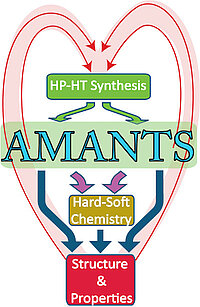Grants
Projects below were supported by a funding agency ( (European Research Council at European scale, Agence Nationale de la Recherche in France, Deutsche Forschungsgemeinschaft in Germany) and heavily rely on the instruments of the High Pressure Lab.
ERC HotCores 2022-2027 : Revealing the unknown planet within the Earth
The Earth’s inner-core (IC) is 1220 km radius planet within the Earth, made of solid iron (Fe) crystallizing from the outer core (OC) as the Earth cools down. Geophysical observations unearth the IC as it is today. Understanding the history of the IC and the effect of the IC on the global Earth dynamics, however, requires a reconstruction based on today’s observations and knowledge of the physical properties of the IC Fe alloy, how they could affect IC dynamics, and their relation with present-day geophysical observables. The HotCore project will reenact key events of the history of the IC in the laboratory, as Fe crystallizes at the inner-
outer-core boundary, as the IC grows and dynamically evolves to its present state, and as we see it today through the lenses of geophysical exploration. What is the structure and dynamics of the IC? How will the IC evolve in the future? HotCores aims at providing the mineralogical foundation that will help solving these mysteries.
ANR Min-Dixi -- 2022-2026 : Mineralogical Diversity in Exoplanets Interiors
Understanding the mechanisms and chemistry in play in the deep Earth without direct rock samples is a strong motivation to study the physical properties and phase relations of materials constituting our planetary interior. In addition to geochemical and cosmochemical constraints, Mineral Physics brings strong insights on the nature of the deep Earth, by comparing the physical properties of geomaterials (silicates and iron alloys) and their Pressure/Temperature phase diagrams to observations such as seismic travel times. Thanks to decades of experiments, we can now describe a model of the chemistry and mineralogical structure of the deep Earth anchored to data and observations.
Beyond Earth, understanding the chemical and mineralogical evolution of silicates and iron alloys is also relevant to characterize the current state of other Solar planets, such as Venus, but also Earth-like exoplanets, including their surface habitability. Processes that formed the Earth structure as we see it today, Venus, and exoplanets, however, remain a challenge for the most advanced models. How to link pristine material as found in some meteorites to the present-day differentiated structure of our planet? Our project will provide mineral physics data to help at solving this question.
In this project, we will rely on a state-of-the-art combination of experiments and ab initio simulations that will allow us to characterize material properties at deep exoplanetary conditions and generate consistent datasets which can be used in planetary models.
ANR AMANTS -- 2019-2023 : "A-site Manganites" pour mAgNetoelectrics et mulTiferroics de contitions extrêmeS
The main objectives of the AMANTS project ("A-site Manganites" pour mAgNetoelectrics et mulTiferroics de contitions extrêmeS) are:
- to synthesise new maganese A-site complex oxides, establish their structures, and explore magnetic and other physical properties,
- to synthesise double-double perovskites based upon the newly-discovered MnRMnSbO6 structure type, and explore magnetic and other physical properties,
- to modify the anion lattices by “hard-soft” chemistry or direct HP synthesis of new Mn2+ A-site manganites with mixed anions,
- to obtain high temperature robust magnets and spintronic materials with enhanced properties due to Mn2+ presence on the A-site and coupling with B,
- to discover new magneto-electric materials based on A-site Mn2+.
ANR MADISON -- 2018-2022 : Multiphase rock deformation in subduction zones
MADISON is motivated by our lack of knowledge on the mechanical behavior of key rocks located in subduction zones, where tectonic plate meet. The mechanical strengths of these rocks play a major role on mass transfers at depths, and on shallow, human-impacting processes such as seismicity and volcanism. The rocks physical properties will be studied by three complementary approaches: in-situ experiments, numerical models and natural samples observations.
ANR-DFG TIMEleSS -- 2018-2022 : Phase TransformatIons, MicrostructurEs, and their Seismic Signals from the Earth's mantle
The TIMEleSS (Phase TransformatIons, MicrostructurEs, and their Seismic Signals from the Earth's mantle) project aims at studying interfaces in the Earth’s mantle combining observations from seismology, mineral physics experiments, microstructures, and wave propagation modeling. It is supported through a bilateral grant, from the ANR in France and the DFG in Germany with partners at Université de Lille, the Westfälische Wilhelms-Universität, Münster, and the Deutsche GeoForschungsZentrum, Potsdam.




![[Translate to English:] Projet ANR Madison](/fileadmin/user_upload/hp-lab/images/Projets/anr-madison.png)
![[Translate to English:] ANR-DFG TIMEleSS](/fileadmin/user_upload/hp-lab/images/Projets/anr-dfg-TIMEleSS.png)